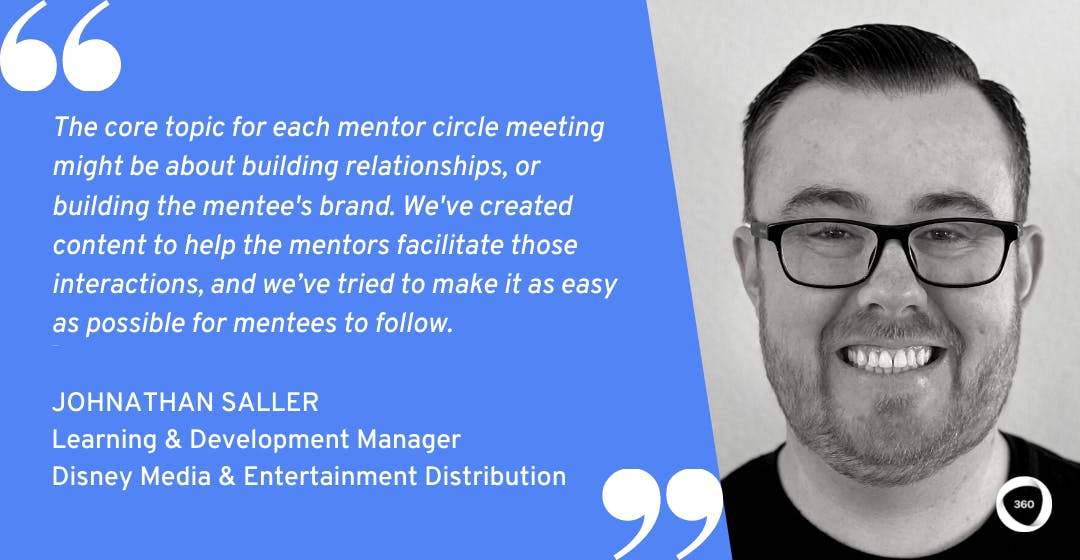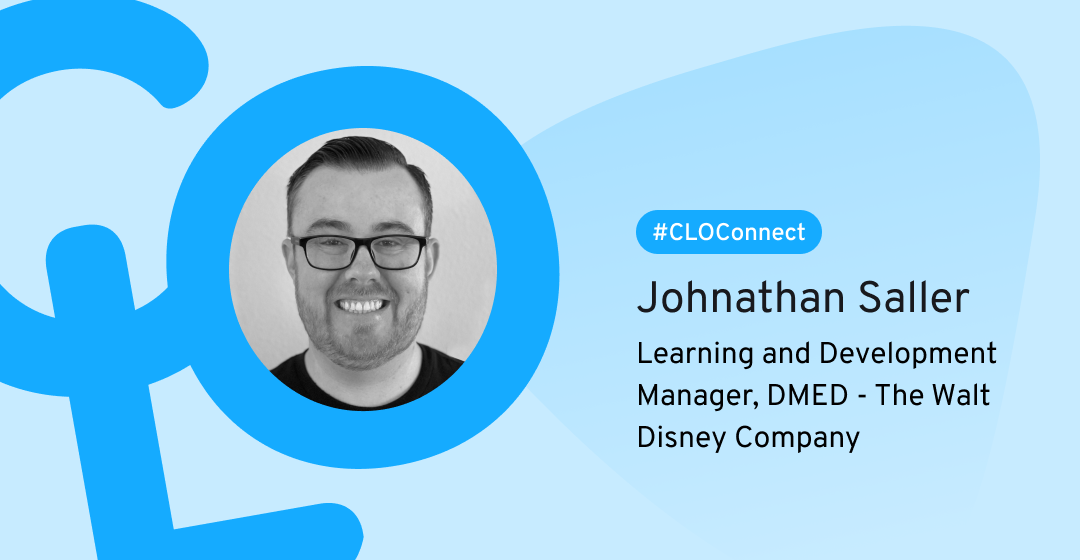For L&D teams everywhere, mentoring programs are one of the best ways to help people grow by sharing internal knowledge and expertise. And contrary to popular belief, mentoring doesn’t just benefit the recipient–it also has huge benefits for mentors, too.
But can you scale your mentoring program to be more than just a one-way flow of guidance and advice? How can you facilitate learning for both mentees and mentors, and make sure everyone gets something out of the relationship?
To answer these important questions, I’m excited to share my conversation with Johnathan Saller, Learning and Development Manager at Disney Media & Entertainment Distribution (DMED). Johnathan was kind enough to tell me all about his four-step approach to creating a mutually beneficial mentoring program.
Read on to discover more about DMED’s practical approach!
Loving what you’re reading? Come and join the L&D Collective for more great learning insights, resources, and events!
The challenge of creating a great mentorship program
Johnathan began our conversation by explaining the challenges DMED faced in developing a great mentor circle program for a specific client: Owned Television Networks (OTV).
“A personal challenge was looking at the feedback from our initial OTV mentoring program pilot and trying to understand what worked, what didn’t, and how to apply those changes to the program,” he says. “Another challenge has been making sure our mentors feel like they are connected to their mentees, whether that’s through different avenues of communication like Slack, email, or Zoom sessions.”
However, the biggest challenge has been managing the expectations of mentors who felt they would be mentoring people in similar career pathways, and balancing those preferences against the pool of applicants to the Mentee program.
“For example,” Johnathan explains, “we might have a mentor who was a news anchor thinking that they would be developing other news anchors. But the pool of mentees isn’t always so neatly matched against our available mentors.”
“Otherwise,” he adds, “the program is running smoothly. We’re halfway through and are about to run our mid-point survey, so we’ll really find out then. But so far, so good.”
Next up, Johnathan explained his four-step approach for designing a mutually beneficial mentor circle program.
Need a few more practical CLO Connect expert insights? Find out How L&D Can Help Your Company Scale.

You have questions–the experts have the answers
By downloading, you agree to our privacy policy.
Another challenge has been making sure our mentors feel like they are connected to their mentees, whether that’s through different avenues of communication like Slack, email, or Zoom sessions.
DMED's 4-steps to a mutually beneficial mentor circle program
As Johnathan explains, DMED OTV’s mentor circle program matches each mentor with two mentees through an open enrollment process based on career preferences and aspirations.
“A part of the application was a questionnaire about what the mentees wanted to do, where they wanted to go, what positions they’re interested in, and the type of mentor they would be looking for,” says Johnathan.
“Some people wanted to have a mentor with experience outside their scope of work to learn about different pieces of the company. When we looked at those applications, we did our best to pair people that wanted to be paired with certain types of mentors. We tried to fill in the blanks as best we could.”
Johnathan and the OTV program team used a four-step process to deliver a mentor circle program to suit everyone’s needs. First up: match people across networks and departments.
Related: The What, Why, and How of Mentorship Programs at Work
Some people wanted to have a mentor with experience outside their scope of work to learn about different pieces of the company.
1. Match across the various television networks to introduce fresh perspectives into each circle
Typically, DMED OTV’s mentor circle program matches mentors and mentees from different stations across the United States. As Johnathan explains, this creates an interesting relationship allowing participants to talk about how different it is to work in either location.
“We really do our best to make sure that mentors and mentees are getting a fresh lens and different point of view when they are having their conversations.”
With this foundation in place, Johnathan then looks at how to curate the right conversations between mentors and mentees.
We really do our best to make sure that mentors and mentees are getting a fresh lens and different point of view when they are having their conversations.
2. Facilitate learning through curated conversations
For Johnathan, the key part of every interaction in the program is a core topic mentors can speak to their mentees about when the whole circle meets every second month.
“The core topic for each mentor circle meeting might be about building relationships, or building the mentee's brand. We’ve created content to help the mentors facilitate those interactions, and we’ve tried to make it as easy as possible for mentees to follow.”

“Then, every other month in between, we have one-on-one time where each mentee can go back and forth with their mentors about whatever they wish to talk about. This helps to give the right amount of flexibility on top of these defined discussion topics.”
3. Create peer-to-peer learning opportunities
Next, Johnathan says that every month they arrange for guest speakers and facilitate peer-to-peer learning opportunities .
“In January we had a speaker come in who had recently written a book that was very relevant to the work that they do. The month before, we had the divisional president speak to the group and get them excited about the program.”
For the mentors, Johnathan and his team have been organizing peer gathering sessions. But from February onwards, they’re handing the keys over to the mentors to run those sessions themselves.
“We have a group of five or six individuals that are developing the next peer gathering session for the 40-ish mentors. They can build it however they want. I believe they’re organizing games, prizes and will talk without us there so they can be more transparent with each other.”
For Johnathan, these frank conversations will be a good chance to gather feedback on DMED’s mentor circle program. “I’m actually really excited for them to have those conversations. I think we’ll get a lot of organic feedback once we do our final survey because they will have had that chance to talk to each other about what’s working and what’s not working.”
Finally, Johnathan talked me through another crucial step in the mentor circle program: having mentees shadow their mentors during actual meetings.
Related: How Johnson Controls Jump-Started its Digital Transformation with a 3-Step Peer Learning Strategy
In January we had a speaker come in who had recently written a book that was very relevant to the work that they do. The month before, we had the divisional president speak to the group and get them excited about the program.
4. Shadowing opportunities to join in-person meetings
Johnathan explains that they ask mentors to allow their mentees to shadow them on an important non-confidential meeting. “The mentees can be a fly on the wall and see how those meetings are run,” he says.
“This might give them some insight into a really cool project that’s coming, or at least get some face time with people they might not otherwise get an opportunity to meet.”
DMED OTV’s circle mentor program demonstrates the value of Collaborative Learning in practice. By giving mentees and mentors the opportunity to share knowledge, DMED is doing a lot to capture and leverage internal expertise. This mutually beneficial approach also enables learners to contribute their own suggestions for the benefit of experts, too.
So, that’s the low-down on DMED’s mentor circle program. But how does Johnathan know the program is running as smoothly as he’d like?
Measuring the success of DMED OTV’s mentor circle program
As Johnathan explains, the theory behind having a mentor circle is one thing–but he wants to make sure the numbers back this up.
“I think the philosophy behind a mentor circle makes sense in theory, because it’s mutually beneficial,” says Johnathan. “But I want to see that reflected in the numbers. In our survey, we have questions like: are you enjoying the mentor program as a circle?”
“In the pilot, we had a similar question. In response, the participants asked for the program to be split between structured circle time and individual time. That’s why I want to make sure that we’re still hitting the right cadence in terms of one-on-one time versus circle.”
As Johnathan explains, DMED is now measuring the success of the OTV mentor circle program in terms of whether the participants feel that they are learning something. “One of the most important questions we have is: are you finding this to be a valuable use of your time? That will tell us whether we should keep it running.”
“As it is a six-month program, we’ll also ask if the program is the right length. The time commitment is probably four to five hours a month over six months, and so there is also a question in our survey asking if people think the time investment is of the right amount.”
Related: 3 Data-Based Ways to Prove Training ROI (+ Free Training ROI Calculator)
One of the most important questions we have is: are you finding this to be a valuable use of your time? That will tell us whether we should keep it running.
Thanks again to Johnathan for so generously sharing his experience and knowledge with us!
If you’re looking for more expert insights on how to leverage internal expertise amongst learners, don’t miss our interviews with Shaun Krietemeyer of Opendoor about using peer learning to meet learners where they are, and with Maggie Romanovich of Constellation Brands about flipping classroom training and freeing peer experts.
Want more peer insights on transforming workplace learning? Sign up to become a member of the L&D Collective, and check out our other #CLOConnect interviews with top L&D leaders on driving growth and scaling culture through Collaborative Learning. Or you can subscribe (below 👇) to our weekly newsletter to receive our latest posts directly in your inbox.


